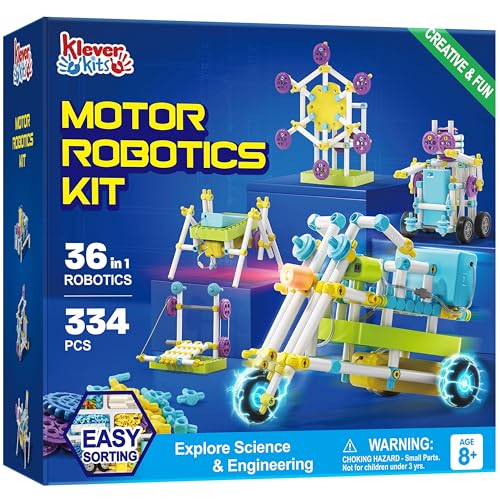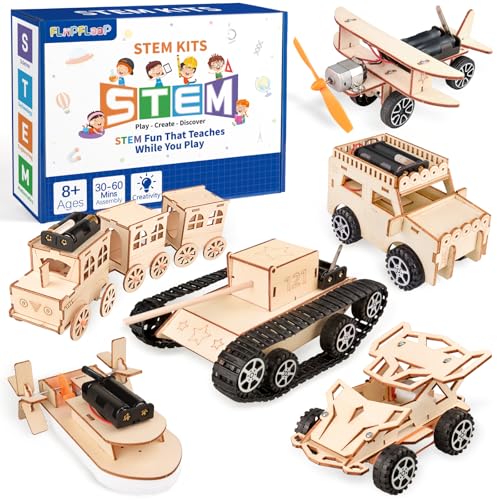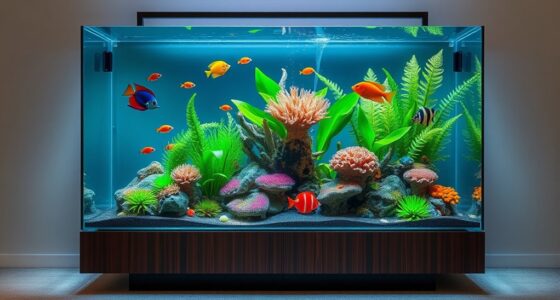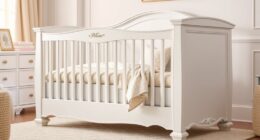If you’re looking for engaging STEM kits for kids, I recommend checking out options like Snap Circuits Jr., Klever Kits, Sillbird Solar Robot, and Poraxy Wooden Kits. These sets make learning fun by combining hands-on projects with science concepts in electronics, robotics, renewable energy, and art. They’re suitable for children aged 5-13, fostering creativity, problem-solving, and critical thinking. Keep exploring to discover more exciting options that nurture curiosity and learning in young minds.
Key Takeaways
- The list includes highly-rated STEM kits like Snap Circuits, Klever Kits, and solar robots that promote hands-on learning and creativity.
- Each kit is tailored for specific age groups, fostering age-appropriate skill development in electronics, engineering, and science.
- Emphasis on educational benefits such as critical thinking, problem-solving, and understanding renewable energy and circuit concepts.
- Safety features and quality materials ensure a secure, durable, and engaging learning experience for children.
- Kits offer diverse projects, from building robots to artistic STEM crafts, making learning fun, interactive, and inspiring curiosity.
Snap Circuits Jr. SC-100 Electronics Exploration Kit
If you’re looking for an engaging way to introduce kids aged 8 and up to electronics, the Snap Circuits Jr. SC-100 Electronics Exploration Kit is perfect. I love how it includes 28 color-coded, numbered components that snap onto a plastic grid without soldering. Kids can build over 100 projects, from alarms to flying saucers, mimicking circuits inside real devices. The easy-to-follow manual with large illustrations guides children step-by-step, helping them learn about switches, circuits, and sound transformation. Safe and simple to use, this kit encourages hands-on experimentation, sparking curiosity and developing problem-solving skills in a fun, educational way.
Best For: children aged 8 and above who are interested in learning about electronics through hands-on, safe, and engaging projects.
Pros:
- Includes 28 color-coded, numbered components that snap onto a plastic grid without soldering, making assembly safe and straightforward
- Allows building over 100 projects, fostering creativity, problem-solving, and understanding of electronic circuits
- Comes with an easy-to-follow manual with large illustrations suitable for young learners
Cons:
- Requires two AA batteries (not included), which may be an additional cost or inconvenience
- Limited to basic projects suitable for beginners; advanced users may seek more complex kits
- The plastic components, while durable for kids, may be less suitable for very rough handling or long-term heavy use
Klever Kits 36-in-1 Motor Robotic Kits for Kids
The Klever Kits 36-in-1 Motor Robotic Kits are an excellent choice for curious kids aged 8 to 13 who love hands-on learning and building projects. With the ability to create 36 different robots, including walking machines and racing cars, this kit sparks creativity and exploration. It promotes understanding of science, engineering, and mechanics while developing problem-solving and logical thinking skills. All parts are organized in a sorting tray, and clear instructions and video tutorials make building easy and fun. Made from safe, durable materials, it’s perfect for solo play or group activities, making learning engaging and interactive.
Best For: curious kids aged 8 to 13 who enjoy hands-on building projects and exploring science, engineering, and mechanics.
Pros:
- Offers 36 different robots to build, including motorized models like walking machines and racing cars
- Encourages creativity, problem-solving, and logical thinking through active construction and experimentation
- Comes with organized parts, a full-color instruction booklet, and video tutorials for easy assembly
Cons:
- May require adult supervision for younger children to ensure proper use of tools and parts
- Some complex models might be challenging for beginners without guidance
- The kit’s focus on mechanical building may not appeal to children interested in digital or virtual activities
Sillbird 12-in-1 Solar Robot Building Kit for Kids
Designed for kids aged 8 to 13, the Sillbird 12-in-1 Solar Robot Building Kit stands out as an excellent choice for young learners enthusiastic to explore STEM concepts through hands-on play. With 190 parts, it allows children to build 12 different models, including robots and cars, increasing in complexity to match their skills. The kit uses an upgraded solar panel that captures more sunlight, providing eco-friendly power for outdoor and indoor play. Easy-to-follow instructions make assembly accessible, fostering independence and family bonding. This kit promotes creativity, problem-solving, and renewable energy awareness, making learning engaging and fun.
Best For: young kids aged 8 to 13 who enjoy hands-on STEM activities and creative building projects.
Pros:
- Encourages STEM learning through engaging, hands-on building experience.
- Powered by an upgraded solar panel suitable for outdoor and indoor play, promoting renewable energy awareness.
- Includes 190 high-quality parts and clear instructions, supporting independent and family-led assembly.
Cons:
- The complexity may be challenging for the youngest users within the age range.
- Requires sufficient sunlight or artificial light, which might limit playtime indoors in low-light conditions.
- Building 12 models might require multiple sessions, potentially leading to longer overall assembly time.
Poraxy 4 in 1 STEM Kits for Kids
Poraxy 4 in 1 STEM Kits are an excellent choice for kids aged 8 to 12 who love hands-on learning and creative projects. I find these kits perfect for sparking imagination while teaching essential engineering concepts. They include parts to build a mini ferris wheel, carousel, fiber optic lamp, and star night light, all made from high-quality laser-cut wood with smooth edges. Kids can assemble, paint, and decorate these models, making each project unique. The finished creations make charming display pieces and introduce children to electrical circuits and coding. This kit combines education with fun, encouraging problem-solving and artistic expression in a compact, durable package.
Best For: kids aged 8 to 12 who enjoy hands-on STEM activities, creative building projects, and learning about electrical circuits and coding in an engaging way.
Pros:
- High-quality laser-cut wooden components with smooth edges for safe, easy assembly
- Combines educational value with decorative appeal through painting, decorating, and lighting effects
- Promotes creativity, problem-solving, and introduces electrical engineering concepts
Cons:
- Suitable primarily for children within a specific age range, may be less engaging for older kids or teenagers
- Requires adult supervision or guidance for younger children during assembly and decorating
- Limited to a set number of projects; may need additional kits for extended activities
60+ Science Experiment Kit for Kids Ages 5-8, STEM Educational Science Gifts
If you’re looking for an engaging way to spark your child’s curiosity about science, this Science Experiment Kit for Kids Ages 5-8 is an excellent choice. It offers over 60 hands-on experiments, like volcanic eruptions, dinosaur egg digging, and lava lamps, that make learning fun and accessible. The kit promotes curiosity, critical thinking, and problem-solving skills while encouraging kids to ask questions and explore scientific concepts. It includes all necessary materials, safety goggles, and easy-to-follow instructions, making it safe and simple for children with parental guidance. Perfect for birthdays, holidays, or summer activities, it helps kids feel like real scientists discovering the wonders of science.
Best For: parents and caregivers seeking an engaging, educational science activity kit for children aged 5-8 to foster curiosity and STEM learning.
Pros:
- Over 60 hands-on experiments make learning fun and diverse.
- Includes all necessary materials, safety goggles, and easy-to-follow instructions for safe use.
- Promotes critical thinking, problem-solving, and scientific curiosity in young children.
Cons:
- Requires parental supervision for some experiments to ensure safety.
- The variety of experiments may be overwhelming for some children to complete in one sitting.
- The kit’s age range (5-8) may not suit children outside this age group or those with advanced science skills.
Science STEM Kits for Kids, Electronics Exploration Kit
The Electronics Exploration Kit stands out as an ideal choice for young aspiring engineers aged 3 to 12 who want hands-on experience with circuitry and electronics. It includes 66 DIY circuit parts and over 1200 projects, all guided by a colorful manual. Kids can build everything from flying saucers to alarms, learning circuitry fundamentals through play. With no tools or soldering needed, parts are color-coded and snap together easily, making setup simple and safe. Recognized with multiple awards, it fosters creativity, problem-solving, and a love for science. It’s perfect for engaging children in screen-free STEM learning, turning complex concepts into fun, practical projects.
Best For: young children aged 3 to 12 who are interested in hands-on electronics, STEM learning, and creative building projects.
Pros:
- Includes 66 DIY circuit parts and over 1200 projects to inspire endless experimentation and learning.
- No tools or soldering required, with color-coded, snap-together pieces for easy, safe assembly.
- Recognized with multiple awards, fostering creativity, problem-solving, and a love of science in a screen-free environment.
Cons:
- May be too advanced for children under age 3, requiring supervision for younger users.
- Limited to physical components, which might be less appealing to children who prefer digital or screen-based activities.
- The size (14.5 x 11 x 3.1 inches) might be cumbersome for storage or travel; some users may desire more compact options.
Science Kits for Kids – STEM Educational Toy Gifts
Science kits for kids stand out as an excellent choice for parents and educators seeking engaging, hands-on STEM toys that foster curiosity and critical thinking. I love how these kits include over 420 projects, 35 circuit parts, and fun accessories like RGB lights and flying saucers. They’re safe and easy to use, with snap-on circuits and no soldering needed—just batteries (not included). The colorful manual and indicator cards guide kids through 118 building methods, boosting confidence and problem-solving skills. Perfect for home or classroom, these kits inspire a love for science while teaching essential physics and electrical concepts in a playful way.
Best For: parents, teachers, and children aged 3-12 who want engaging, educational STEM activities that promote hands-on learning and creativity.
Pros:
- Includes over 420 projects and 35 circuit parts to keep kids entertained and challenged
- Safe, easy-to-use snap-on circuits without the need for soldering or extra tools
- Encourages curiosity, confidence, and problem-solving with detailed manuals and diverse experiment options
Cons:
- Batteries are not included, so additional purchase may be necessary
- The kit’s size (14.5 x 11 x 3.1 inches) may require designated storage space
- Some components or projects might be too advanced for very young children without adult supervision
National Geographic STEM Science Kit for Kids
Looking for a STEM kit that combines engaging experiments with educational depth? The National Geographic STEM Science Kit for Kids is perfect. It features over 15 hands-on activities, like creating water tornadoes, erupting volcanoes, and growing crystals. Designed for children 8 and up, it promotes exploration and discovery of Earth sciences while encouraging teamwork. The kit includes a detailed, colorful Learning Guide that explains scientific principles clearly, building confidence in young scientists. Made by JMW Sales, Inc., it’s durable and backed by excellent customer service. With high ratings and a competitive price, it’s an engaging way to make science fun and educational.
Best For: children aged 8 and above who are eager to explore Earth sciences through engaging, hands-on experiments that foster curiosity and teamwork.
Pros:
- Includes over 15 hands-on experiments such as volcanoes, tornadoes, and crystal growth for varied learning experiences
- Comes with a detailed, colorful Learning Guide that clearly explains scientific principles, boosting confidence
- Manufactured by JMW Sales, Inc., ensuring high-quality, durable materials backed by excellent customer service
Cons:
- May require adult supervision for some activities to ensure safety and proper execution
- Limited to certain experiments; may not cover all areas of Earth sciences in depth
- Only available for purchase through Amazon, which could limit access in some regions
UNGLINGA 150 Experiments Science Kits for Kids
If you’re searching for an extensive STEM kit that keeps kids engaged and enthusiastic to learn, UNGLINGA 150 Experiments Science Kits stands out as an excellent choice. It offers 150 hands-on projects covering earth sciences, chemistry, physics, and more, making science exciting and accessible. The kit includes high-quality tools and kid-friendly materials, allowing children to perform experiments just like real scientists. With a clear, step-by-step manual, kids can easily follow instructions and explore scientific concepts at home or school. Perfect for ages 8 and up, this kit fosters curiosity while promoting fun learning for birthdays, holidays, or weekend activities.
Best For: parents, teachers, and kids aged 8 and up who want engaging, educational science activities that foster curiosity and hands-on learning.
Pros:
- Offers 150 diverse experiments in earth sciences, chemistry, physics, and more for comprehensive STEM learning
- Includes high-quality lab tools and kid-friendly materials for safe, real-scientist experiences
- Well-illustrated, step-by-step manual simplifies learning and enhances independent exploration
Cons:
- The size and weight (11.42 x 8.67 x 3.94 inches, 3.25 pounds) may make storage or transport less convenient
- Requires household items for some experiments, which might necessitate additional shopping or preparation
- As a large kit, it may be more expensive compared to smaller, simpler science sets
Dan&Darci Light-Up Terrarium Kit for Kids
For children aged 6 to 12 who love hands-on projects, the Dan&Darci Light-Up Terrarium Kit stands out as an engaging way to explore nature and science. This kit lets kids create their own miniature garden inside a jar, complete with rocks, soil, sand, and tiny decorations like a bunny and mushroom. The LED-lit lid adds a magical glow at night, making the terrarium visually stunning. It encourages kids to learn about ecosystems, plant growth, and environmental responsibility through a fun, creative activity. Easy-to-follow instructions make assembly simple, making it a perfect gift for young science enthusiasts.
Best For: children aged 6-12 who enjoy hands-on, educational science and craft projects that foster creativity and curiosity about nature.
Pros:
- Encourages STEM learning by teaching about ecosystems, plant growth, and environmental responsibility.
- Features a magical LED-lit lid that enhances visual appeal and nighttime enjoyment.
- Includes all necessary materials with easy-to-follow instructions, making assembly simple and accessible for young children.
Cons:
- The kit’s small size may limit the complexity of the garden or decorations.
- Some children might need adult supervision for certain steps, especially handling small miniatures or tools.
- The LED light requires recharging via Micro-USB, which may be less convenient if the cable is misplaced.
6-in-1 STEM Kits for Kids Aged 8-12
In-1 STEM kits for kids aged 8-12 stand out as versatile, all-in-one solutions that combine multiple projects into a single set, making them ideal for young learners with diverse interests. These kits include six different models built from durable, safe wooden pieces, providing hands-on experience with physics, motion, energy transfer, and electricity. Suitable for ages 8-13, they promote active experimentation and critical thinking while reducing screen time. Perfect for birthdays or holidays, they encourage teamwork, communication, and creativity. With engaging, educational activities, these kits make learning fun, foster curiosity, and help kids develop essential STEM skills through collaborative problem-solving.
Best For: children aged 8-13 who are interested in hands-on STEM learning, creative building projects, and family activities that promote teamwork and critical thinking.
Pros:
- Offers six different engaging models to enhance diverse STEM skills and creativity
- Made from durable, safe wooden materials suitable for young children
- Encourages family bonding and collaborative learning while reducing screen time
Cons:
- Requires AA batteries (not included), which may require additional purchase
- Some assembly may be challenging for younger children without adult help
- Limited to specific age range, so not suitable for much younger or older children
STEM Electric Circuit Kit for Kids Ages 8-12
The STEM Electric Circuit Kit for Kids Ages 8-12 stands out as an excellent choice for young learners enthusiastic to explore electrical concepts through hands-on experiments. It offers 8 engaging activities, such as series and parallel circuits, saltwater power, and fruit batteries, promoting critical thinking and creativity. The kit includes clear instructions and all necessary components (batteries not included), making it perfect for home, school, or science fairs. With a focus on conductivity and energy transfer, it provides a thorough, fun introduction to electrical engineering fundamentals. Weighing just 9.1 ounces, it’s compact, portable, and highly rated for its educational value.
Best For: young learners aged 8-12 who are eager to explore electrical concepts through hands-on experiments and educational activities.
Pros:
- Includes 8 engaging experiments that demonstrate key electrical principles such as series and parallel circuits, saltwater power generation, and fruit batteries.
- Comes with a detailed circuit book with easy-to-follow instructions, suitable for beginners and classroom use.
- Promotes critical thinking, creativity, and problem-solving skills in a fun, interactive way.
Cons:
- Batteries are not included, so additional purchase may be necessary to complete experiments.
- Some components may be small, requiring careful supervision for younger children.
- Weight and size might limit portability for very active or outdoor use.
UNGLINGA Science Lab Experiments Kit for Kids
If you’re looking to spark your child’s curiosity about science, the UNGLINGA Science Lab Experiments Kit is an excellent choice, especially for kids aged 8 and up who love hands-on learning. With over 50 engaging activities, it covers earth science, chemistry, and magic experiments using household items. Kids can create volcano eruptions, grow gemstones, and produce rainbow rain—all while developing critical thinking and problem-solving skills. The kit includes a detailed guide that explains the science behind each activity, making learning fun and accessible. Made from high-quality materials, it offers hours of educational exploration, perfect for independent or shared family experiments.
Best For: children aged 8 and up who are interested in hands-on science experiments and STEM learning at home or in educational settings.
Pros:
- Offers over 50 engaging and educational science activities covering earth, chemistry, and magic experiments.
- Includes a detailed learning guide that explains the science behind each activity, fostering deeper understanding.
- Made from high-quality materials, providing safe, fun, and hours of exploration for independent or group use.
Cons:
- The kit may require supervision for younger children to ensure safe handling of certain materials.
- Some experiments might need additional household items not included in the kit.
- The size and weight (9.8 x 7.5 x 3.2 inches, 1.79 pounds) might be less portable for on-the-go use.
Learning Resources STEM Explorers Pixel Art Challenge
Designed for young learners aged 5 and up, the Learning Resources STEM Explorers Pixel Art Challenge stands out as an engaging tool that combines creativity with foundational STEM skills. It promotes critical thinking, problem-solving, spatial reasoning, and fine motor skills through fun activities. Kids manipulate foam pieces to complete patterns, build designs, and develop hand-eye coordination. The set includes 10 challenge cards with increasing difficulty levels, blending art with STEM concepts like coding, math, and engineering. Made from safe, durable materials, it’s perfect for independent, classroom, or homeschool use, encouraging screen-free, tactile learning that sparks curiosity and technical skills.
Best For: young children aged 5 and up, educators, and parents seeking engaging, hands-on STEM and art activities that promote critical thinking and fine motor skills.
Pros:
- Promotes development of critical thinking, problem-solving, and spatial reasoning skills.
- Safe, durable, lightweight foam pieces designed for easy manipulation and active play.
- Offers progressive challenges with multiple difficulty levels, suitable for various ages and skill sets.
Cons:
- May require adult supervision for younger children to ensure proper use of challenge cards.
- Limited to tactile, screen-free activities, which might need to be complemented with digital learning tools.
- Storage of multiple pieces and challenge cards could become clutter without proper organization.
Science Kits for Kids – STEM Kits with Electronics Exploration and 140+ Projects
Children aged 3 to 12 who are curious about electronics will find these STEM kits to be an excellent choice. They include over 140 projects, like fans, RGB lamps, and flying saucers, that make learning engaging and hands-on. The kits use colorful manuals and indicator cards to guide kids step-by-step through building circuits with safe, solder-free components. Designed for ease and safety, they require no extra tools—just snap the parts onto a plastic plate and insert batteries (not included). Perfect for classrooms or gifts, these kits foster curiosity, problem-solving, and a love for physics and engineering in young learners.
Best For: children aged 3-12 who are curious about electronics and want to learn through hands-on, safe, and engaging STEM projects.
Pros:
- Includes over 140 projects to keep children engaged and foster creativity.
- Solder-free and easy to use, requiring only snap-on components and batteries (not included).
- Comes with colorful manuals and indicator cards that simplify complex concepts for young learners.
Cons:
- Batteries are not included, so additional purchase is necessary.
- Limited to plastic snap components, which may restrict certain advanced project explorations.
- Suitable primarily for supervised use with very young children (age 3), as younger kids may need assistance.
Factors to Consider When Choosing Educational STEM Kits for Kids

When selecting a STEM kit, I always consider the child’s age to make certain it’s suitable and engaging. I also look at the educational focus and safety features to guarantee the kit promotes learning without risks. Ultimately, I evaluate the building complexity and creative potential to find a perfect balance that challenges and inspires them.
Age Appropriateness
How do you guarantee a STEM kit is both safe and engaging for your child? First, I check the recommended age range on the packaging to ensure it matches my child’s developmental level. Choosing kits with appropriate complexity is key—simple circuits for younger kids, more advanced projects for older children—to prevent frustration or boredom. I also consider the size and safety of small parts, especially for children under age 8, to avoid choking hazards. Additionally, I look for kits with clear instructions and age-specific content, which helps keep my child interested and ensures they fully understand the concepts. By paying attention to these factors, I can select a STEM kit that’s both safe and perfectly suited to my child’s age and abilities.
Educational Focus
Choosing a STEM kit that truly promotes educational growth means paying close attention to the concepts it emphasizes. I look for kits that focus on core topics like circuitry, engineering principles, or scientific inquiry, as these directly support STEM skill development. Clear and thorough instructions are essential—easy-to-follow manuals encourage independent learning and help troubleshoot issues. I also prioritize kits with hands-on, experiential activities that keep kids actively involved, reinforcing learning through practice. Additionally, I check if the kit fosters creativity, problem-solving, and critical thinking, which are essential for a well-rounded STEM education. By ensuring these factors are met, I can select kits that not only engage children but also nurture their curiosity and understanding of complex concepts.
Safety Features
Safety features are a vital aspect of selecting educational STEM kits, as they directly impact a child’s well-being during hands-on activities. I always check that the kit is made from non-toxic, BPA-free, and child-safe materials to prevent health hazards. Secure, shatterproof, and durable components are essential to reduce the risk of breakage and injury. It’s also important that the kit includes safety features like insulated wiring, low-voltage power sources, and protective covers for electrical parts, ensuring safe handling during experiments. Clear safety instructions and age-appropriate warnings help guide proper use and prevent accidents. Finally, I look for certifications or endorsements from safety organizations, which confirm the kit meets recognized safety standards for children. These features give me peace of mind while kids explore and learn.
Building Complexity
Selecting a STEM kit that matches a child’s age and skill level is essential to keeping their interest high and preventing frustration. I recommend choosing kits with adjustable difficulty or multiple projects so children can grow their skills without feeling overwhelmed or bored. It’s also important to check if the instructions are clear and detailed, catering to both beginners and more advanced learners. Safety is key, so guarantee the components are durable and appropriate for the child’s developmental stage. Balancing building complexity with educational value helps foster critical thinking and problem-solving skills. A well-chosen kit challenges without frustrating, encouraging sustained engagement and learning. Remember, the right level of difficulty keeps children motivated and enthusiastic to explore more.
Creative Potential
When evaluating STEM kits for their creative potential, I look for options that offer a wide variety of projects, as this diversity encourages kids to explore different ideas and develop their unique designs. Kits with customizable components are especially valuable because they allow children to modify and personalize their creations, fostering innovation and artistic expression. I also consider whether the kit includes both guided and open-ended activities, which promote imaginative problem-solving and creative thinking. High-quality, colorful, and tactile materials are important because they boost engagement and inspire kids to experiment confidently. Lastly, I prefer kits that can be upgraded or expanded with additional parts, ensuring ongoing creative development and maintaining long-term interest. These factors truly access a child’s inventive potential.
Frequently Asked Questions
What Safety Precautions Should Parents Supervise During STEM Kit Activities?
I always supervise my kids closely during STEM activities to guarantee safety. I make sure they wear protective gear like goggles and gloves when necessary, and I keep small parts away from younger children to prevent choking hazards. I also teach them to handle tools carefully and follow instructions step-by-step. Staying attentive and involved helps prevent accidents and makes the learning experience safe and enjoyable for everyone.
How Do STEM Kits Support Different Age Groups’ Learning Capabilities?
Imagine a garden where each plant blooms at its own pace—that’s how STEM kits support different age groups. I see them as tailored tools that nurture young minds at various developmental stages, offering simpler experiments for beginners and more complex challenges for older kids. These kits act like stepping stones, helping kids grow their skills and confidence, making learning a personalized adventure that adapts as they progress.
Are There STEM Kits Designed for Children With Special Learning Needs?
Yes, there are STEM kits specifically designed for children with special learning needs. I’ve found that these kits often feature simplified instructions, sensory-friendly components, and adaptable activities that cater to different abilities. They promote inclusivity and help build confidence. I recommend looking for kits labeled as accessible or tailored for special needs, as they encourage hands-on learning and make STEM education enjoyable for every child.
Can STEM Kits Be Integrated Into Classroom Curricula Effectively?
Absolutely, STEM kits can be effectively integrated into classroom curricula. I recommend aligning activities with learning objectives and incorporating them into existing lesson plans. Using kits as hands-on projects or group activities keeps students engaged and reinforces concepts. I also suggest evaluating progress regularly to guarantee the kits support curriculum goals. When used thoughtfully, these kits enhance understanding and make learning both fun and meaningful for students.
What Maintenance or Replacement Parts Are Needed for Long-Term Use?
Think of STEM kits as gardens that need tending to flourish. For long-term use, I recommend regularly checking batteries, replacing worn-out components, and cleaning sensors or moving parts to keep everything running smoothly. Keep an eye on fragile pieces and have spare parts handy for quick fixes. This way, your kit remains a vibrant learning tool, always ready to inspire curiosity and innovation in young minds.
Conclusion
Imagine your child’s eyes lighting up as they build, explore, and discover with these STEM kits. Each kit is a gateway to a world of curiosity, where tiny hands craft glowing circuits or robotic marvels. Watching them immerse in these engaging activities is like witnessing sparks of wonder ignite. So, choose a kit that sparks their imagination and watch their love for learning grow brighter with every experiment.

























